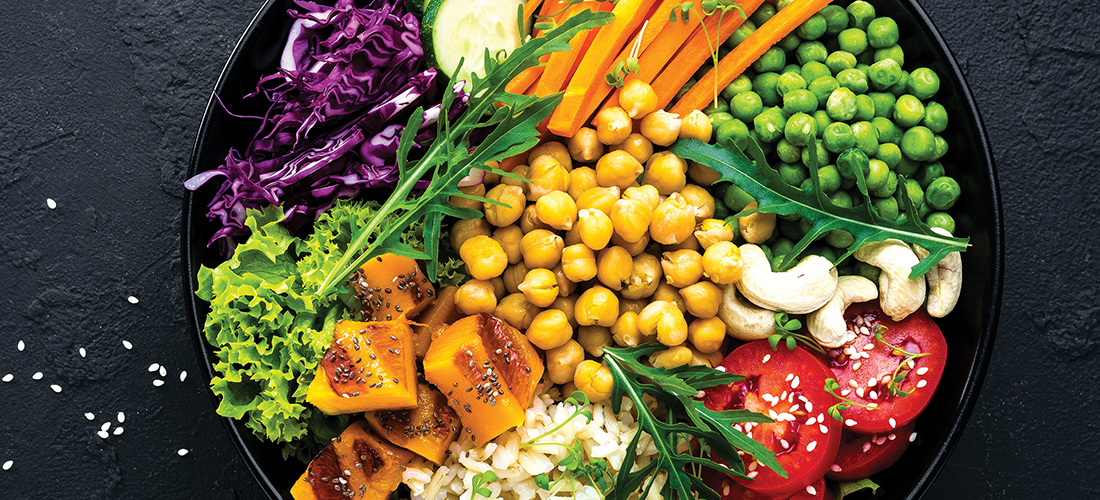
Ode to the Veg
Or: Eat, drink and be merry, for tomorrow we diet
By Jan Leitschuh
It happens every January.
As penance for the rich feasting of the holidays, the unrestrained, celebratory consumption/imbibing of pecan pies, creamy dips, butter sauces, eggnog (and other tipsy spirits), gravies, mocha-mint lattes and, of course, peppermint ice cream, we find ourselves in January, contemplating our softening middles, spreading bottoms and muffin tops. A powerful craving for a Christmas cookie and fruitcake detox takes hold.
So we sign up for the gym and start a diet. We step away from the metaphorical sugarplums.
Can’t help with the gym, that’s on you.
Now, diet, here we can brainstorm. Kitchen gardeners may even have a leg up here. Isn’t your freezer full of produce picked at seasonal peak from the garden or local farmers markets?
Think about it — so many diets out there to choose from. There are the old classics: Mediterranean, Atkins, South Beach, Weight Watchers, grapefruit, cabbage and more. There are the more recent diet entries such as Whole 30, TLC, DASH, the Zone, the Warrior, Paleo and ketogenic.
There is so much confusing info. Are eggs bad for you — or good? Is dairy a healthy food — or not? Legumes — hard-to-digest gut-disrupter or heart-healthy protein source? Wheat toast and whole grain pasta — dietary staples or ketosis-killing carbohydrates? And don’t even start on meat — blood sugar-stabilizing muscle-builder or cardiovascular scourge?
And yet, there is one simple category everyone can agree on. Virtually every diet and meal plan encourages their consumption.
Vegetables. Yep.
No matter one’s choice of diet, vegetables form the true backbone of a sensible eating plan and healthy weight management program. And let’s get real — it’s just plain hard to start a complicated “diet” in bleak, cold, gloomy, dark of January, but it’s not that complicated to drop the junk and fill that void with more veggies. It’s a simple plan, with health uppermost. Keep it simple and start subbing out the sugar, fat and alcohol for an extra helping of nutrition.
Start with advice from the USDA: “Five-to-Nine a Day For Better Health.” For many people, it may seem like a huge amount, especially if you aren’t a vegetable fan. But there are simple ways to up the veggie ante. More on that in a minute.
We’ll start with some sympathy. If you cling to the “I don’t like vegetables” mantra, it’s possible science has some support for you: It could be your genetics. Researchers with the University of Kentucky School of Medicine recently discovered that a particular gene might cause some people to be particularly sensitive to the taste of the brassicas — radishes, broccoli, Brussels sprouts, cabbage and other bitter-tasting veggies.
That’s not a “get-out-of-diet” free card, more of an understanding of how one’s preferences might shape a search for produce one might like. There’s still folate-rich spinach, or fat-satisfying avocado, high vitamin-C red peppers, glutathione (the master antioxidant) rich asparagus, or the medium starchy indulgence of a sweet potato. Zucchini, avocadoes, cucumber, mushrooms, celery, tomatoes, onion, eggplant, garlic, sprouts and microgreens, carrots, yellow squash, green beans, and onions will work too. For starters.
As we learn more about the human gut biome, we are learning how vital plant material is to its (and thus, our) health and diversity. Fiber, found only in plant foods, is one factor. A recent study found that those with the greatest weekly diversity of dietary plants had — surprise — the greatest diversity of beneficial gut bacteria. Eating 30 different plants a week can seem daunting, but this study included nuts, fruits, seeds, grains, spices and more. (Yes, spices are a type of health and taste-promoting plant food. Consider turmeric, basil, ginger, sage, black pepper, garlic and more.)
Fruits are sweet, healthy and tasty, but for some might be less than helpful if weight loss is a goal. The fructose, or fruit sugar, is one type of carbohydrate that can trigger blood sugar spikes in diabetics or those with metabolic syndrome, and may push keto dieters out of ketosis. Yet fruit in judicious quantities is healthy and delightful. During a January push, think low-sugar fruits such as a few blueberries in your almond-flour pancakes, a sprinkle of raspberries atop yogurt or mascarpone, or a squeeze of lemon or lime in dressings or tonic water. Save the bananas, figs, grapes, dried fruit and mangoes for celebratory treats down the line.
Non-starchy vegetables are naturally lower in calories, so if you are pushing for weight loss rather than health and maintenance, you might also want to give the potatoes a miss for a few weeks. Eat the foods on the DASH food plan: fish and lean protein, high-fiber starches, and deep orange and green-colored vegetables, berries and nuts.
So, let’s huddle about sneaking a few more vegetables painlessly into our daily lives. The secret is simple. Start at breakfast. And then keep it up.
The simplest breakfast veg start is the classic veggie omelet. Sauté a few of your favorites, and whip up some eggs and pour. The sauté could include any combo of chopped onions, mushrooms, asparagus, spinach or other greens, tomatoes, broccoli and more. On the side, add a few slices of avocado or tomato. For a Mexican scramble, add a dash of salsa atop your eggs, and a small side of black beans. For a Greek, spinach and feta. And so on. Or go all Scandinavian and add slices of tomato and cucumber to your breakfast smorgasbord. The classic green smoothie is breakfast rocket fuel.
Lunch is easy. Many folks enjoy a lunch salad, and there are lots of ways to add more vegetable variety here. The advent of prepared veggies such as shaved carrots and beets, cucumber slices, etc., in the supermarket makes things easy. Or run through the market’s salad bar and pick out the items you wouldn’t buy or prepare at home, and add them to your own base of greens. Instead of sandwiches, use lettuce or collards for wraps. Serve an asparagus quiche. A bit of Sunday afternoon preparation in the kitchen could yield, say, a hearty white bean and kale soup or chili one could sup all week.
In fact, vegetable soup is a very good way to pack in both more veggie variety and quantity. Use an immersion blender and puree them all together if you don’t enjoy vegetable chunks.
Snack on your favorite finger veggies, adding a light smear of something enjoyable to, say, celery. Or mash up a batch of avocados and toss in a little onion and tomato.
As for supper, that’s the easiest. Fill the plate three-quarters full with vegetables. Your traditional side veggies will do. A small sweet potato microwaved is a quick side and a treat. Instead of pasta for your next Italian spaghetti, try spaghetti squash or spiralized zucchini strips, “zoodles,” as a vegetable-rich base. Use riced cauliflower instead of rice in a soup or dish — they are sneaking cauliflower into everything these days. Asian, Italian and Indian cuisines pack many veggies into one dish — think ratatouille, moo goo gai pan or stir-fries and curries. Any casserole can shelter extra vegs.
Make spicy “chips” of kale, sweet potatoes and more. For lasagna, use strips of squashes instead of traditional lasagna noodles. Stuff some bell peppers. Grill some kebabs and use a whole lot of grape tomatoes, mushrooms, squash rounds, peppers and onion. Up the veggie ration in your fajitas, or pad out your meatloaf with your friends in the plant kingdom.
No matter your dietary goals, health or weight loss, you can’t go wrong working a few more veggies into your daily feeds.
Now, go forth and detox! PS
Jan Leitschuh is a local gardener, avid eater of fresh produce and co-founder of the Sandhills Farm to Table cooperative.





